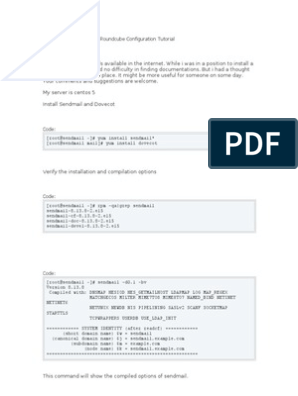Advanced Installation Tips for iRedMail
http://code.google.com/p/iredmail/w iki/Installation_Tips March 19, 2012
If you already have MySQL server running in your local net, you can use it to store virtual domains and users.
*********************************************************** **** WARNING: BACKUP ALL DATA BEFORE WE GO FURTHER. **** ***********************************************************
1. Configure iRedMail as above, but when it ask 'Contine? [Y|n]', choose no to continue:
Configuration completed . ************************************************************************* **************************** WARNNING *********************************** ************************************************************************* * * * Please do remember to *REMOVE* configuration file after installation * * completed successfully. * * * * * /root/iRedMail-x.y.z/config # <- config file location * * ************************************************************************* <<< iRedMail >>> Continue? [Y|n] # <-Type 'n' or 'N' here to exit installation <<< iRedMail >>> Canceled, Exit.
2. Edit 'iRedMail-x.y.z/conf/mysql', find these variables:
export export export export export export MYSQL_FRESH_INSTALLATION='YES' MYSQL_SERVER='127.0.0.1' MYSQL_PORT='3306' MYSQL_SOCKET='/var/lib/mysql/mysql.sock' MYSQL_ROOT_USER='root' MYSQL_ROOT_PASSWD='passwd'
3. Use your exist MySQL server info here:
export MYSQL_FRESH_INSTALLATION='NO' # <Set to 'NO' so that iRedMail won't install mysql-server. export MYSQL_SERVER='192.168.122.249' # <- MySQL server address. export MYSQL_PORT='3306' # <- MySQL server port. export MYSQL_SOCKET='/var/lib/mysql/mysql.sock' export MYSQL_ROOT_USER='root' # <MySQL root user, iRedMail will use it to import some databases. export MYSQL_ROOT_PASSWD='secret' # <- MySQL root user's password.
4. If your Apache and PHP are not installed in standard directory, you should edit 'conf/httpd' to change them:
# # HTTPD_SERVERROOT: Apache server root, default is # - /var/www (RHEL/CentOS) # - /usr/share/apache2 (Debian) # HTTPD_DOCUMENTROOT: Document root, default is # - /var/www/html (RHEL/CentOS) # - /var/www/default-site (Debian) # export HTTPD_SERVERROOT='/var/www' export HTTPD_DOCUMENTROOT="${HTTPD_SERVERROOT}/html/" export HTTPD_CONF="/etc/httpd/conf/httpd.conf" export HTTPD_CONF_DIR="/etc/httpd/conf.d" export PHP_MODULES_DIR="${HTTPD_SERVERROOT}/lib/php/modules/"
�export PHP_MODULES_DIR="${HTTPD_SERVERROOT}/lib/php/modules/" export HTTPD_SSL_CONF= "${HTTPD_CONF_DIR}/ssl.conf"
5. If you already have all Apache+PHP+MySQL related binary packages installed, you must tell iRedMail not to install them in conf/global:
export USE_EXIST_AMP='YES'
6. If you just want iRedMail not to install MySQL related binary packages, you must edit 'functions/packages.sh', remove mysql related packages. Such as php-mysql, mysql-server, mysql, mysql-client, etc. 7. OK, re-execute the main script:
# bash iRedMail.sh <<< iRedMail >>> Check configuration file: /root/iRedMail-x.y.z/config... Found. <<< Question >>> Use it for mail server setting? [y|N]y # <Type 'y' or 'Y' here <<< iRedMail >>> Use configuration file: /root/iRedMail-x.y.z/config for mail se rver setting. ...
Although maildir is recommended (more popular, better performance) and default mailbox format, but iRedMail also support mbox format. Modify 'iRedMail-x.y.z/conf/global', change 'HOME_MAILBOX' to 'mbox' before you start iRedMail installation:
# Maildir format: mbox, Maildir. HOME_MAILBOX='mbox'
Start iRedMail installation now.





















































































